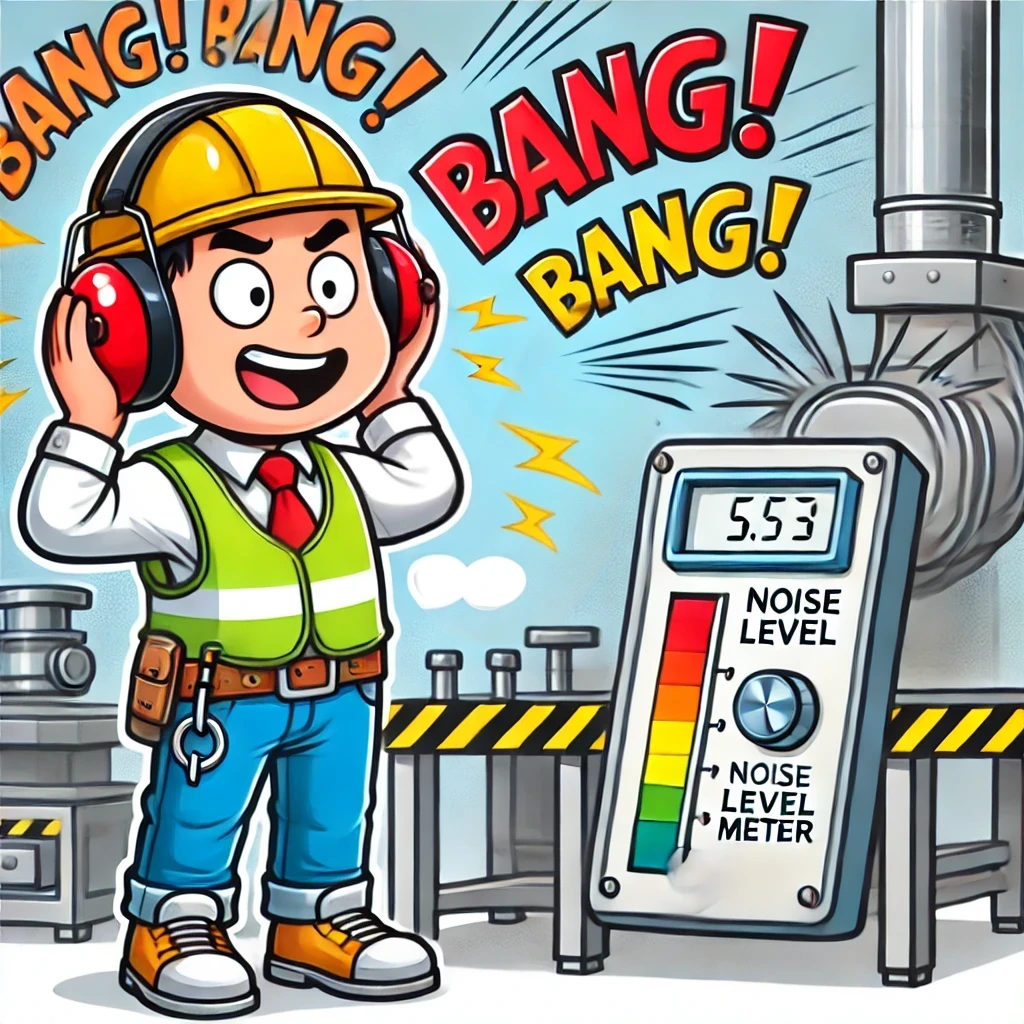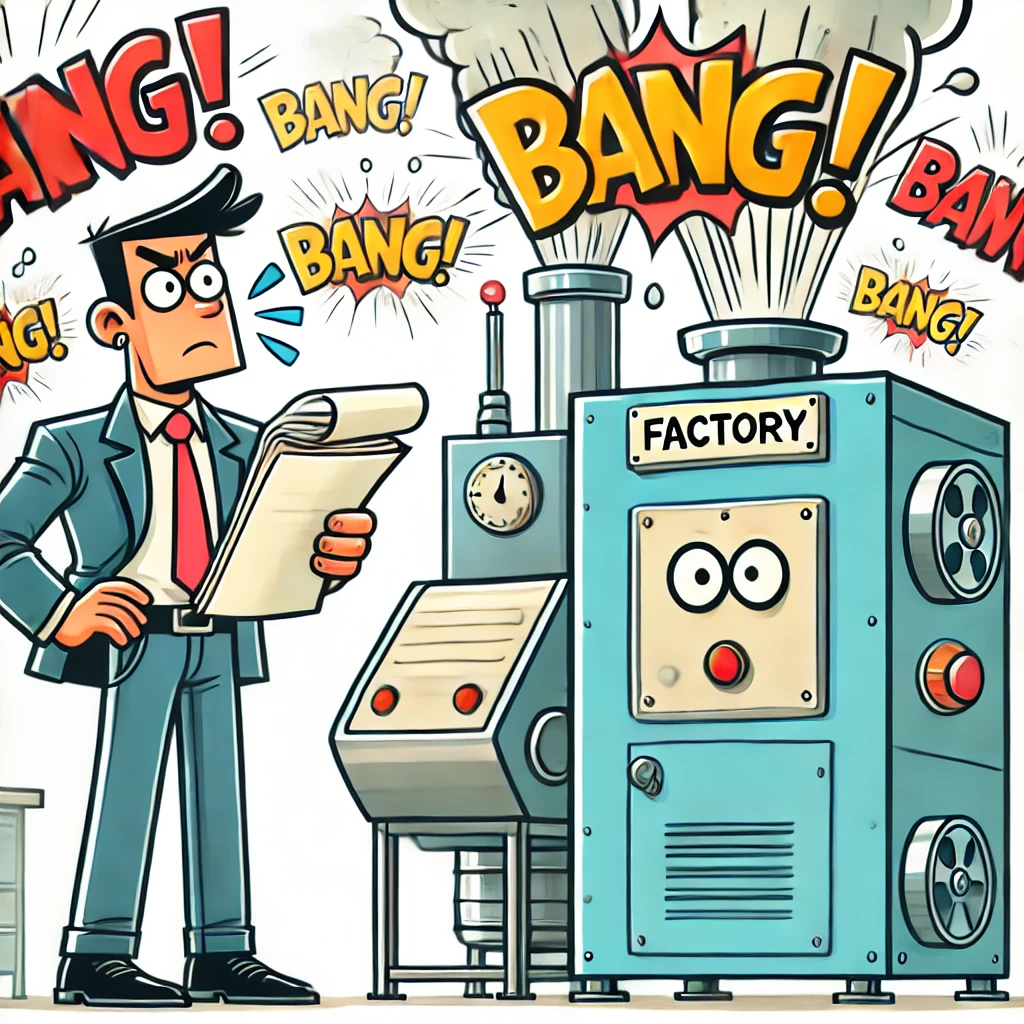In modern industrial automation and machinery design, efficiency and adherence to stringent safety standards are paramount. A critical aspect of this is the Machine Noise Study and Machinery and Production Line Design, which significantly impacts the comfort and health of operators. Standards like PN-EN ISO 11202:2012 play a crucial role in CE certification and legal compliance.
Table of Contents
PN-EN ISO 11202:2012: Key Aspects of Machine Noise Study
The PN-EN ISO 11202:2012 standard, a harmonized version of the international ISO 11202, pertains to methods for measuring noise emitted by machinery and equipment. It is a vital document for the industrial automation and machinery design sectors, as it sets standards and procedures for measuring sound pressure levels at workstations and specific locations.

This standard precisely defines how to conduct a Machine Noise Study to achieve reliable and repeatable results. The measurement methods in the standard address constant, variable, and impulsive noise. These measurements are crucial for meeting the requirements of the Machinery Directive 2006/42/EC and obtaining CE marking.
One of the main objectives of the PN-EN ISO 11202:2012 standard is to determine sound pressure emission levels directly at the workstation and other locations around the machine. For engineers and industrial automation integrators, knowledge of these levels is crucial when designing and automating production processes. This standard also supports measurement processes by providing detailed guidelines on microphone placement, environmental conditions, and measurement techniques.
Preparation for measurement according to the PN-EN ISO 11202:2012 standard involves several key steps. First, identify all potential noise sources in the work environment. Next, measurement locations must be carefully determined to reflect actual working conditions of the machine. The standard also requires the use of appropriate measurement tools, such as microphones and acoustic calibrators compliant with IEC 61672-1:2002, which must be regularly calibrated, especially during a safety audit.
Measurement procedures include precise sound pressure measurements at various points around the machine under different operating conditions. An important element is also considering environmental corrections K3A, which aim to adjust measurement results to better reflect actual acoustic conditions in the workplace. Analysis of measurement results leads to the development of a detailed report containing data on the machine noise study and recommendations for corrective actions.
The PN-EN ISO 11202 standard is also a key document in the context of adapting machines to essential requirements. It enables manufacturers to conduct a comprehensive acoustic assessment of their products, which is necessary to obtain CE certification. This ensures that machines can be safely operated, and the risk associated with excessive noise is minimized.
Understanding and properly applying the PN-EN ISO 11202 standard is essential for companies involved in machinery design, industrial robotics, and production automation. Implementing these standards helps ensure regulatory compliance, improves working conditions for operators, and supports overall efficiency and safety in industrial plants.
When applying the PN-EN ISO 11202:2012 standard, it is advisable to also consider numerical calculations (FEM) and modal analysis during the design phase. FEM calculations help identify potential strength issues that may lead to increased noise. Modal analysis allows for the identification and control of vibrations, which are one of the main sources of noise in machines. Using these tools allows for designing machines in a way that minimizes noise generation, directly improving working conditions and compliance with standards.
The PN-EN ISO 11202 standard provides comprehensive guidelines necessary to ensure that machines are safe, efficient, and compliant with international standards. It is a foundation for companies striving for excellence in production process automation and ensuring the highest safety standards in their products.

Machine Noise Study: Measurement Methodology
The Machine Noise Study is crucial for CE machine certification. The measurement methodology involves several stages that must be conducted with due diligence to ensure accuracy and reliability of results.
- Preparation for Measurement:
- Identify all noise sources in the “design office.” This includes both machines and auxiliary devices that may affect noise levels.
- Determine measurement locations according to the PN-EN ISO 11202:2012 standard. This requires precise determination of workstations and other points where noise may be particularly troublesome.
- Measurement Equipment:
- Use microphones and calibrators compliant with IEC 61672-1:2002. Proper measurement tools are crucial for obtaining accurate machine noise study results.
- Regular calibration of measurement equipment, which is crucial during a safety audit. Calibration discrepancies can lead to incorrect results and non-compliance with standards.
- Measurement Procedures:
- Measure sound pressure at the workstation and other locations according to the standard. This procedure requires precise measurements under different machine operating conditions.
- Use machine guards and sound-absorbing screens if necessary. These elements can significantly reduce noise levels, which is important for compliance with standards.
- Analysis of Results:
- Consider environmental corrections K3A. This correction is necessary to reflect actual working conditions.
- Develop a report with measurement results and recommendations for adapting machines to essential requirements. The report should contain detailed data on noise levels and recommendations for their reduction.
Machine Noise Study: Importance of CE Certification
The Machine Noise Study is an integral part of the CE machine certification process. CE marking confirms compliance with the requirements of the Machinery Directive 2006/42/EC and the Machinery Regulation 2023/1230. Conducting accurate noise measurements and their analysis are crucial for obtaining the EC declaration of conformity. This means that the machine is safe to use and does not pose excessive risk to operators’ health.
Risk Analysis According to PN-EN ISO 12100:2012
During the design and automation of production processes, a risk analysis according to PN-EN ISO 12100:2012 must be conducted. This process includes:
- Hazard Identification: In the context of noise, identify all potential sources that may contribute to excessive noise at the workstation.
- Risk Assessment: Determine the degree of risk associated with noise and its impact on employees’ health. This requires a detailed analysis of noise measurement results and comparison with permissible standards.
- Determine Risk Mitigation Measures: Implement technical and organizational solutions aimed at reducing noise levels. These may include design changes and the use of machine guards.
Also check:
Machine Runout Study
Low Voltage Directive LVD 2014/35/EU
EMC Directive: Key Requirements and Challenges for Engineers
Practical Aspects of Implementing Standards
Engineers responsible for machine design must consider acoustic standard requirements at every stage.
- Design Optimization:
- Design machines to minimize noise generation. This may include using sound-absorbing materials, proper acoustic insulation, and optimizing drives and mechanisms.
- Use harmonized standards to ensure compliance with international acoustic standards.
- Production Process Control:
- Monitor and regulate production processes to minimize noise sources. Regular inspections and audits are essential to maintain compliance with standards.
- Conduct FAT (Factory Acceptance Test) and SAT (Site Acceptance Test), including machine noise study at various production stages.
- Regular Inspections and Maintenance:
- Ensure regular inspections and maintenance of machines to avoid increased noise due to component wear. Maintaining the technical condition of machines is crucial for maintaining their compliance with standards.
Integration of FEM Calculations and Modal Analysis
Numerical calculations (FEM) and modal analysis can significantly contribute to noise reduction in machines. Modal analysis allows for the identification and control of vibrations, which are one of the main sources of noise in machines.
- Modal Analysis:
- Use modal analysis to identify resonant frequencies that may cause excessive vibrations and noise.
- Optimize machine design to reduce vibrations, which directly impacts noise reduction.
- Application of FEM Calculations:
- Strength calculations (FEM) are essential to ensure that the machine structure is sufficiently rigid and does not generate additional noise through uncontrolled vibrations.
- FEM analysis helps identify potential strength issues that may lead to increased noise.
Machine Noise Study: Employer’s Role in Noise Control
The Machine Noise Study does not end at the design and production stage. According to the Tool Directive, employers are required to regularly check noise levels in workplaces. This process includes:
- Regular safety audits, which can be carried out by external companies offering engineering outsourcing.
- Monitoring and documenting noise levels at various points in the production facility.
- Implementing remedial measures in case of exceeding permissible noise levels, such as improving acoustic insulation or using machine guards.
Conclusion
The Machine Noise Study is an indispensable element of modern industrial machinery design and production automation. Meeting acoustic standard requirements not only improves working comfort but is also crucial for machine safety and obtaining the CE mark. Attention to proper machine design, regular safety audits, and adapting machines to essential requirements are the foundations of effective and safe industrial automation.
FAQ: Machine Noise Study
Machine Noise Study is the process of measuring sound pressure levels emitted by machines and equipment to assess their compliance with safety and comfort standards.
A Machine Noise Study is crucial for protecting operators’ health and comfort and for meeting legal requirements, such as the Machinery Directive 2006/42/EC and obtaining CE marking.
The main standard regulating Machine Noise Study is PN-EN ISO 11202:2010, which specifies methods for measuring sound pressure levels at workstations and specific locations around the machine.
The preparation stages for a Machine Noise Study include identifying noise sources, determining measurement locations, selecting appropriate measurement tools, and calibrating equipment.
For a Machine Noise Study, microphones, acoustic calibrators compliant with IEC 61672-1:2002, and other precise measurement devices are used.
Environmental corrections K3A are adjustments made during a Machine Noise Study to account for the impact of environmental conditions on measurement results.
CE certification requires machines to meet safety requirements regarding noise according to the Machinery Directive 2006/42/EC. Machine Noise Study is an integral part of this process.
A Machine Noise Study should be conducted regularly, in accordance with legal regulations and safety guidelines, to monitor noise levels and implement necessary corrections.
Not conducting a Machine Noise Study can lead to exposing operators to health risks, non-compliance with legal regulations, issues with obtaining CE certification, and potential legal sanctions.
To reduce machine noise, sound-absorbing guards can be used, machine design can be modified, modal analysis and strength calculations (FEM) can be conducted, and regular maintenance and monitoring of the machine’s technical condition can be performed.
Zobacz także:
Napisz do nas!
Chętnie odpowiemy na Twoje pytania!
